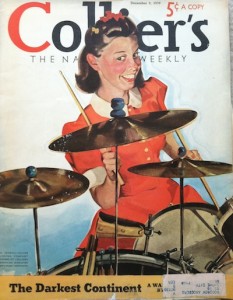 If you’ve been reading this column regularly, you know that one of the most sought after items by yours truly are old magazines–Life, Look, Collier’s, The Saturday Evening Post (pre-1970s), and the sweet, sweet Mad magazines of yesteryear (again, pre-1970s, mostly because I own most of those.) You almost always find Life; the others are a bit more difficult.
If you’ve been reading this column regularly, you know that one of the most sought after items by yours truly are old magazines–Life, Look, Collier’s, The Saturday Evening Post (pre-1970s), and the sweet, sweet Mad magazines of yesteryear (again, pre-1970s, mostly because I own most of those.) You almost always find Life; the others are a bit more difficult.
Over the circuit this weekend, Thursday through Sunday, I emerged with copies of all the aforementioned periodicals, and heavens-to-Betsy, they didn’t stink as though they’d been stored with the bodies of dead mice. That’s good.
To be honest, though, outside of Mad, I read very few of the articles and short stories in these crumbly weeklies. What intrigues me are the advertisements. Ads have changed and they haven’t changed–though they were a lot more wordy back in the day, they still prey on the usual fears and concerns: death, sexuality, thrills and chills, hunger. Some of them are downright offensive, reflecting the time’s sexism; others, as you will see, are downright disgusting.
This was a strange week–a lot of sales, but not a whole lot of good stuff. We were joined by ESC visiting dignitary Mayor Mike Haeg and First Lady Tammy Dahlke, who came away with some great arts and crafts materials that they will no doubt put to good use (since they possess talents other than being able to kill an evening with beer and fifty-year-old magazines.) But outside of two stinky, though fascinating sales, this weekend’s “clean” sales really didn’t reveal a whole lot.
 Our trek began Friday afternoon, in a strange home on Nicollet Avenue, tucked away behind a tangle of shrubs. This was a totally run down home, with moldy boxes and a pile of broken asphalt roof shingles in its weedy yard. Inside, there were piles and piles of stuff–the typical “diggers” sale, but sadly, almost everything stank or was broken.
Our trek began Friday afternoon, in a strange home on Nicollet Avenue, tucked away behind a tangle of shrubs. This was a totally run down home, with moldy boxes and a pile of broken asphalt roof shingles in its weedy yard. Inside, there were piles and piles of stuff–the typical “diggers” sale, but sadly, almost everything stank or was broken.
This was a house full of weird little surprises. Tons of minatures–little red shadowboxes with cheap plastic furniture arranged to look like a living room, a kitchen, a bedroom. Lots and lots of trinketry, books that had little to no value (I did find an old copy of The Maltese Falcon, which was too beat up to be of any lasting worth, other than something to read.) Go into the kitchen and avoid the basement, because ten feet from the door that led down to that dungeon, the smell of mildew was so intense it gave me a headache. Nothing in the kitchen… but open that cabinet door, and you see the Killer Pig collage pasted to the inside (right.) Yikes!
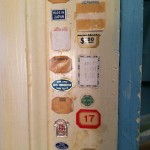 Upstairs, we see more junk–tons and tons of Matchbox cars, or rather, miniature cars. I’m not sure if they were the name brand Matchbox or Hot Wheels cars. Go into the closet (stinky clothes), and there, on the wall, are the stickers from years’ accumulation of “dry clean” stickers, “made in Japan”, “100% pure linen”, Dayton’s price tags, and more. Tiny, tiny stickers, dotting the wood like so many spores of mold.
Upstairs, we see more junk–tons and tons of Matchbox cars, or rather, miniature cars. I’m not sure if they were the name brand Matchbox or Hot Wheels cars. Go into the closet (stinky clothes), and there, on the wall, are the stickers from years’ accumulation of “dry clean” stickers, “made in Japan”, “100% pure linen”, Dayton’s price tags, and more. Tiny, tiny stickers, dotting the wood like so many spores of mold.
 This guy’s collection of toy semi-trucks was cool, though nothing I’d buy. Since a lot of them were from the 1970s, I found that kind of neat. You had your K-Mart and Ben Franklin trucks, some company called Price Chopper, and this, “Humpin’ to Please” (from Campbell “86″ Express, a trucking concern that is still kicking today.) Also, hidden away beneath piles of other G-rated material, a stack of paperback porno novels and dirty joke books (titles include The Twisted Triangle.)
This guy’s collection of toy semi-trucks was cool, though nothing I’d buy. Since a lot of them were from the 1970s, I found that kind of neat. You had your K-Mart and Ben Franklin trucks, some company called Price Chopper, and this, “Humpin’ to Please” (from Campbell “86″ Express, a trucking concern that is still kicking today.) Also, hidden away beneath piles of other G-rated material, a stack of paperback porno novels and dirty joke books (titles include The Twisted Triangle.)
But I did grab a few old Collier’s magazines from back in the day (see cover at the top of this piece.) Collier’s was a popular magazine in its day, catering to the better-off, as evidenced by all the advertising aimed at folks who had money in 1931. Products like radios and United Airlines travel (New York to the Pacific Coast in 31 hours, at $160)–both items the middle class didn’t buy regularly at the height of the Depression.
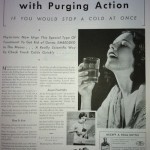 Apparently, the upper middle class suffered an epidemic of colds and coughs, and were profoundly upset by this turn of events. Lavoris (left), a Minneapolis manufacturer, paid for a full page advertisement in this august weekly. My God, look at all that ad copy! And man, it’s a doozy.
Apparently, the upper middle class suffered an epidemic of colds and coughs, and were profoundly upset by this turn of events. Lavoris (left), a Minneapolis manufacturer, paid for a full page advertisement in this august weekly. My God, look at all that ad copy! And man, it’s a doozy.
“Physicians Now Urge This Special Type Of Treatment To Get Rid of Germs EMBEDDED In The Mucus…” Yes, friends, mucus was a problem. Please finish whatever it is you’re eating! From the ad copy:
How It Acts
The action of Lavoris in the mouth and throat will be a revelation to you.
First: It loosens, “cuts’ and removes dangerous, germ-laden mucus. Turns it into a “curd” so you can expel it easily and quickly.
You can see the shreds with your own eyes. Thus you know that bacteria are washed out because the mucus that they lodge in is flushed out…
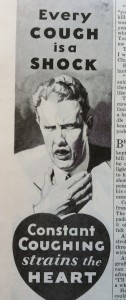 I remain amazed that there was a ever a time when a gentleman sat with his pipe and brandy and welcomed discussion of mucus curds. Honey, would you bring me another plate of oysters and beef aspic? Thank you…
I remain amazed that there was a ever a time when a gentleman sat with his pipe and brandy and welcomed discussion of mucus curds. Honey, would you bring me another plate of oysters and beef aspic? Thank you…
Collier’s is full of advertisements addressing myriad life-threatening problems, all solved by “medicines” that were probably just water and pencil shavings. Coughs cause heart-attacks (right)! Another favorite: “Dosing with Laxatives had made the condition worse!” Yes, that’s probably true, and the solution is… Fleischmann’s Yeast cakes? Eat three a day, dissolved in water. Fucking hell.
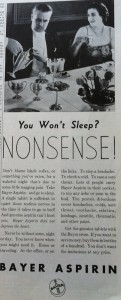 “You won’t sleep?” ask the folks at Bayer Aspirin. “NONSENSE!” God damn it, you fucking idiot, how dare you blame the alcohol you’ve been pounding down your throat since lunch, the two packs of unfiltered cigarettes you’ve been sucking on since dawn, or the pot of black coffee you guzzled late into the night. Eat God Damn Bayer Aspirin every minute, and you’ll sleep… not that you deserve it. Oh, and buy the name brand. “You don’t want imitations at any price!” No sir.
“You won’t sleep?” ask the folks at Bayer Aspirin. “NONSENSE!” God damn it, you fucking idiot, how dare you blame the alcohol you’ve been pounding down your throat since lunch, the two packs of unfiltered cigarettes you’ve been sucking on since dawn, or the pot of black coffee you guzzled late into the night. Eat God Damn Bayer Aspirin every minute, and you’ll sleep… not that you deserve it. Oh, and buy the name brand. “You don’t want imitations at any price!” No sir.
There were tons more, more agonized faces locked in a rictus of coughing jags (one solution was from the Vapex Company, whose Vapex–and they spell it out for you, V-A-P-E-X, since seeing it in print obviously is not enough–a liquid menthol you pour out in drops on your pillow and handkerchief and huff all day); depressed wives who simply cannot believe that fate dealt them the cruel blow of marrying a man with stubble on his chin; after-shave lotions that “feed” the skin, preventing gangrenous inflammation to appear on the jaw; and Tums, good ol’ Tums, which helps ease “gassy fullness, burning sourness, and belching nausea.”
How anyone surved the 30s, I’ll never know.
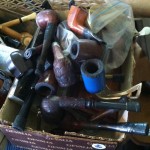 Saturday saw the Haehlkes and Schillouts head to sunny Golden Valley and then Edina. As I said, the pickings were slim, but the first house on our route held promise. This was a strange rambler, clad in green stained cedar, packed to the rafters with crap, and sporting a long line that took us about a half hour to get through. Once inside, we came upon the life’s work of an entire family who hoarded.
Saturday saw the Haehlkes and Schillouts head to sunny Golden Valley and then Edina. As I said, the pickings were slim, but the first house on our route held promise. This was a strange rambler, clad in green stained cedar, packed to the rafters with crap, and sporting a long line that took us about a half hour to get through. Once inside, we came upon the life’s work of an entire family who hoarded.
There were women’s shoes, books, cook books, Edison music cylinders, rock posters, pipes, swords by the dozen, plastic cups, old magazines, clothes, lamps, video tapes, and beer cans by the hundreds. Wandering through what would have been the living room, but was now just a repository of accumulated detritus, I was stunned to find that there were actually not that many different items, but dozens upon dozens of similar things–like those pipes. Cool pipes, but worthless since they were so beat up and chewed upon. At least it appeared as though whomever collected these (the Hennepin County Property Records didn’t reveal a name) got good use of them.
I also found it funny that, buried in one corner was a gumball machine, with a “Not For Sale” sign on it, probably the only thing in the house that wasn’t for sale. That must’ve been some gumball machine.
 The basement was creepy and disturbing, even darker than the upstairs, but reeking of mold. The walls were lined with either beer cans or bottles, and virtually no organization had been done (though I’m guessing it was still a ton of work–probably there was garbage piled over all this.) Anything decent had been ruined by the dampness–like an old 1966 Minnesota Twins calendar, bent and ripped and dotted with spores. There were tons of old Playboy magazines that stank, and one corner, with a flickering, half-dead fluorescent bulb dribbing milky light, had dozens of rock posters, scattered about like the scrolls of the Alexandria Library after the looting. The dim light reminded the Mayor of the basement in The Blair Witch Project. “I half expected to find a kid standing in the corner,” he said, shuddering.
The basement was creepy and disturbing, even darker than the upstairs, but reeking of mold. The walls were lined with either beer cans or bottles, and virtually no organization had been done (though I’m guessing it was still a ton of work–probably there was garbage piled over all this.) Anything decent had been ruined by the dampness–like an old 1966 Minnesota Twins calendar, bent and ripped and dotted with spores. There were tons of old Playboy magazines that stank, and one corner, with a flickering, half-dead fluorescent bulb dribbing milky light, had dozens of rock posters, scattered about like the scrolls of the Alexandria Library after the looting. The dim light reminded the Mayor of the basement in The Blair Witch Project. “I half expected to find a kid standing in the corner,” he said, shuddering.
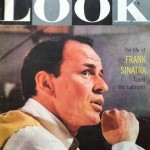 But I did emerge with a sort-of prize: a stack of old Mad magazines, a Saturday Evening Post, and a few Life and Look magazines from upstairs (meaning, they didn’t stink.) Only one of the eight Mads turned out to be a deal–the others had images clipped from them, unfortunately.
But I did emerge with a sort-of prize: a stack of old Mad magazines, a Saturday Evening Post, and a few Life and Look magazines from upstairs (meaning, they didn’t stink.) Only one of the eight Mads turned out to be a deal–the others had images clipped from them, unfortunately.
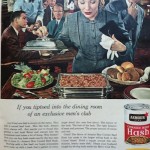 I spent Sunday morning drinking coffee and perusing these magazines, whose dates spanned from the mid-50s to the early 70s. Once again, it was the freaky advertising that wowed me.
I spent Sunday morning drinking coffee and perusing these magazines, whose dates spanned from the mid-50s to the early 70s. Once again, it was the freaky advertising that wowed me.
The Look magazine from May, 1957 was the best, offering up a wide variety of strange appeals. Gone are most of the concerns about coughs and yeast, now we have a healthy America that just needs to buy, buy, buy! Everything from delicious cigarettes and booze, to the crappy packaged foodstuffs that became the rage after the big war. Dig the one for Armour Corned Beef hash (left.) “If you tiptoed into the dining room of an exclusive men’s club…” I guess her efforts to go unnoticed failed miserably, since everyone’s gaping at Cate Blanchett’s mother sniffing at the dog food. “There’s always one item on the menu…”, and it’s baffling, since my guess is that “exclusive men’s clubs” are damned expensive, and they probably sought better things to eat than a can of mealy Armour Corned Beef hash.
 Don’t ask me why, but I love all this stuff, even as it makes me a bit sad, since so many of that generation suffered as a result of eating this crap, and smoking their lives away. This sort of deadly innocence is fascinating to me… and everyone else, I assume, since Mad Men is such a popular show. There were the usual subtly sexual ads for beer, one of which clearly implies that oral sex is to be equated with Budweiser, full page spreads for Postum, a hideous hot beverage that tastes like wet cardboard (“This cactus makes me thirsty… let’s have more Postum!”), mothers and daughters whispering conspiratorially about the benefits of the Kotex belt. But then, there’s this incredible ad for Canadian Club, featuring “Baseball’s Grandpa” (above right.)
Don’t ask me why, but I love all this stuff, even as it makes me a bit sad, since so many of that generation suffered as a result of eating this crap, and smoking their lives away. This sort of deadly innocence is fascinating to me… and everyone else, I assume, since Mad Men is such a popular show. There were the usual subtly sexual ads for beer, one of which clearly implies that oral sex is to be equated with Budweiser, full page spreads for Postum, a hideous hot beverage that tastes like wet cardboard (“This cactus makes me thirsty… let’s have more Postum!”), mothers and daughters whispering conspiratorially about the benefits of the Kotex belt. But then, there’s this incredible ad for Canadian Club, featuring “Baseball’s Grandpa” (above right.)
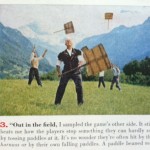 The photos and text tell a story of a man who traveled to Switzerland in search of fun and games. He found it all right: the game of Hornussen, or hornet. As the text sez:
The photos and text tell a story of a man who traveled to Switzerland in search of fun and games. He found it all right: the game of Hornussen, or hornet. As the text sez:
“Instead of a ball, they use a disc that hums through the air like a hornet. Outfielders try to stop it by throwing paddles into the air. I joined a game outside Interlaken, in the shadow of the mighty Jungfrau–and soon wished I’d stuck to sandlot softball.”
As you can see from the detail above left, the gentleman joined the fun, tossing these giant paddles into the air to stop the hornet from advancing. “It’s no wonder [the players] are often hit by the hornuss or by their own falling paddles. A paddle beaned me.”
Those italics are courtesy of our friends at Canadian Club. Apparently, his head injury sent our man back to the Beau-Rivage Hotel where “Canadian Club looked better than a big-league pennant.”
OK, that’s all fun, but what the hell?!? Hornussen? Seriously? Apparently, it is still played today…
My favorite ads, however, and one of the sheer joys of this sale, were the contrasts between satire and reality. Mad magazine had a lot of fun in their day poking fun at the current crop of advertisements. I’ve been reading old Mads literally since I was a kid, devouring the paperback digests that collected material from the 50s and 60s, and that I found in old used book stores in Northern Michigan. Even at age 12 I was a nostalgist, and Mad’s take on old TV and print ads amused me. But on this occasion, for the first time in my life, I was able to contrast the Mad version with its real-life counterpart in Life and The Saturday Evening Post.

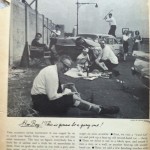 Consider this Liberty Mutual ad in the April, 1957 Saturday Evening Post (left) to its tongue-and-cheek counterpart in the March 1962 Mad (right–and you can click on the images to make the image larger.) For starters, since there’s a five year difference, I’m guessing Liberty Mutual must’ve really kept this campaign going. And it’s totally worthy of scorn–if you look close to the real ad, it’s obvious that the car has been damaged for a long time, or else rust occurs in this part of America with alarming swiftness.
Consider this Liberty Mutual ad in the April, 1957 Saturday Evening Post (left) to its tongue-and-cheek counterpart in the March 1962 Mad (right–and you can click on the images to make the image larger.) For starters, since there’s a five year difference, I’m guessing Liberty Mutual must’ve really kept this campaign going. And it’s totally worthy of scorn–if you look close to the real ad, it’s obvious that the car has been damaged for a long time, or else rust occurs in this part of America with alarming swiftness.
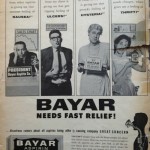 In a December, 1961 Mad, there’s also an ad for “Bayar” aspirin, which raises a question I’ve pondered many a year–how the hell does Bayer still remain in business? Why would you buy name brand aspirin, for God’s sake? “I take Bayar because the decline in the value of my stock is giving me that panicky feeling of HYSTERIA!” claims the Madvertisement, noting that Bayer must’ve been losing ground by the mile even then. Maybe Bayer had the market cornered in 1931, and could browbeat customers into thinking their very sleep depended on a steady diet of buffered aspirin from Bayer, but no more.
In a December, 1961 Mad, there’s also an ad for “Bayar” aspirin, which raises a question I’ve pondered many a year–how the hell does Bayer still remain in business? Why would you buy name brand aspirin, for God’s sake? “I take Bayar because the decline in the value of my stock is giving me that panicky feeling of HYSTERIA!” claims the Madvertisement, noting that Bayer must’ve been losing ground by the mile even then. Maybe Bayer had the market cornered in 1931, and could browbeat customers into thinking their very sleep depended on a steady diet of buffered aspirin from Bayer, but no more.
Advertisements are themselves a form of art, often a mini-story told in so many words. Most are terribly annoying, damaging even, rotten imagery designed to destroy your spirit so that you can fill that gaping wound with beer, McDonald’s hamburgers, make-up, diet pills. Look at the ads of yesterday, and laugh–how did people ever think a disposable raincoat made of paper was any good (or not adding to the pollution problem–this one’s from a 1969 Life magazine.) But ask yourself this question: what are the laughable ads of this generation? Not funny ads, but those ads that we’ll look back on and wonder, “how could people have been so stupid?” The answer, I’m sure, isn’t that simple–we’re all gullible fools to some degree.
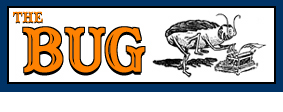

Whoop hoo i made the article! Thanks for letting me tag along!